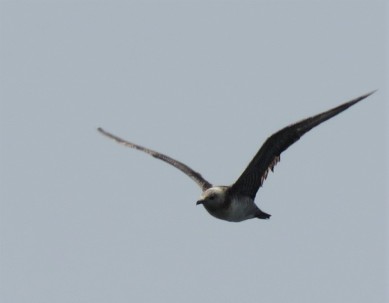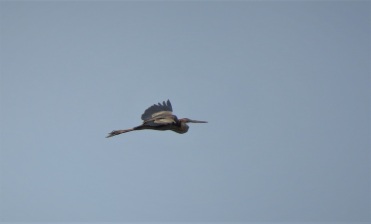Ngor seabird migration update
Fifty-one sessions, 69 hours, 23,693 birds, 54 species: this, in summary, is the result of the past three months of seawatching from Ngor.
We still have about two months to go until the end of the season (does it really ever stop? There’s always birds on the move off Ngor!), but I thought I’d give a quick update of what the season has been like so far. I did six sessions in early August, then started doing regular one to two hour spot checks from August 21st. The only interruption was from 7-17 September when I was in Mali, but other than that I managed to go on most days, usually in the morning. Miguel accompanied me on a couple of occasions and provided additional counts for two days. All observations – in the sake of consistency! – were made from the Calao terrace, which may not be as good as Ile de Ngor, but it definitely has the advantage of being easily accessible, and what’s more there’s shade and decent coffee.

I won’t go into a review for each species as I may do this at the end of the season, so here are just a few highlights so far, along with a few recycled pictures because except for a few blurry pictures of migrating Whimbrels or a Purple Heron I don’t have much to offer.
- Shearwaters
The main species here is Sooty Shearwater, which is seen in varying numbers during almost all seawatch sessions since Sept. 18th. The first three birds are noted on 4/9, and so far there have been small peak days on 18 & 20/9, 3/10, 14 and 16/10 with a max. of 164 birds in one hour on 3/10 (out of a total of 1,411 birds counted). This morning there finally was a pretty much constant flow of shearwaters, with 284 Sooties zooming past in less than two hours (= nearly 3 per minute).
The only other regular species is Manx Shearwater, seen during 18 out of 30 sessions since 18/9 – usually between one and five birds, with a max. of 31 in 75′ on 20/9. A Cape Verde Shearwater flew past on 31/8, while 11 birds were feeding off the Calao, luckily at fairly close range, on 11/10. A Balearic and a probable Boyd’s Shearwater were seen on 23/9 and 18/9, respectively.
- Storm-Petrels
A very unpredictable group of pelagic species, which occurs in highly variable numbers from year to year – at least, based on what passage can be seen from land. As already mentioned, some 50 birds were feeding off the Calao on July 22nd with 3 still there two days later. The next Oceanodroma petrels were seen on 8/10 only (4 birds during SSW winds), followed by three on 11/10, then at least 80 on 15/10 (when we counted seabirds for 4 hours and 15 minutes) and a handful on following days. Most if not all of these were Wilson’s Storm-petrel, though it’s quite possible that there were a few Band-rumped (Madeiran) Storm-petrels in the lot. We really ought to get out at sea to get a closer look at these difficult birds – hopefully something we can manage to do in mid-November when we’re planning a pelagic.
- Sulidae (Gannets & Boobies)
An early Gannet flew past on 18/9, though I can’t say for sure it was a Northern Gannet and not the vagrant Cape Gannet; the only other one so far was seen yesterday afternoon. This species should become increasingly common in coming weeks. Single Brown Boobies were seen on 18/9, 24/9 and 29/9, though only one was flying SW (could it have been three times the same immature bird?). Haven’t been back to Iles de la Madeleine for a few months now but it’s likely that several Brown Boobies are hanging out there at the moment.
- Waders
Though this group is not made up of seabirds (except maybe Grey Phalaropes in winter), they can often be seen migrating along the coast, sometimes up to about a kilometer out at sea. Best days for waders are early on in the season (Aug./Sept.) during the peak migration time for most species, and particularly when it’s been raining during the night and early morning.
This was the case for instance on 24/8, when a good variety of waders were seen in 1.5 hours under light rain, after a heavy shower that started around 6am and with moderate SSW winds. About 39 Bar-tailed Godwits were counted, in four groups, all except one mixed with Whimbrels; also 13 Turnstones, a Common Redshank, a Common Sandpiper, four Little Stints, 16 Sanderling, four Curlew Sandpipers, and five Ruff (with godwits).
Whimbrel is the most regular and most numerous of the waders, with 528 birds actively migrating so far. More than half of these (293) flew past on 9/8. Other species noted include Oystercatcher (regular in small numbers), Common Ringed Plover (five on 6/10), Greenshank (one on 15/10, and even Curlew (two on 5/9).
A single Grey Phalarope flew past at relatively close range on 18/9, while a flock of ca. 25 waders on 30/8 were probably this species as well.
- Skuas
The first skuas were noted on Aug. 11th when four Long-tailed Skuas flew past. From Aug. 23rd the passage gradually intensifies, with just a few fairly small peak dates so far: 31/8 (13 Long-tailed Skuas, first few Pomarines), 21/9 (104 total skuas in 75′), and this morning 21/10 (171 in 105 minutes). So far, out of 1,385 skuas counted, just over half could be identified to species. Out of these, 52% were Arctic Skuas, 32% Pomarines, and the remaining 15% Long-tailed. It seems that in recent days the balance of Arctic vs. Pomarine Skuas is tilting towards the latter species, which is most numerous in November.
Sixteen Catharacta skuas (=South Polar or Great) flew past between Aug. 23rd and this morning, with seven in the past three days. At least one of these clearly was a South Polar Skua, an intermediate form; one of this morning’s birds flew quite close to the shore and looked very dark, faintly streaked, and appeared to be very bulky: features that point to Great Skua. Going by last year, more should follow in coming days.
- Gulls
The first Sabine’s Gull is seen as early as August 5th, but it’s not until the end of the month that the species becomes more or less regular: two on 30/8, three on 31/8 and one the following day. The first small peak day is on 21/9 when 66 birds fly past in 75′; other good days were Oct. 10th (84 in 90′), 16th (214 in 150′), and 18th (94 in 60′). Up to now, we’ve counted 654 birds, almost all on days with moderate (20+ km/h) W to NNW winds – though it’s still quite rare to see them flying past at close range, being usually quite far out on the horizon and just about recognisable by their flashing black-white-grey plumage.
Audouin’s and Lesser Black-backed Gulls are much less regular, and so are Slender-billed and Grey-headed Gulls. Probable Kelp Gulls flew past on 11/8 and 30/8.
- Terns
With over 19,000 migrating terns counted, this group is by far the most numerous of all. The Arctic/Common “species pair”, often indistinguishable or too cumbersome to identify down to species level, represents nearly 50% of all terns, with just over 9,000 birds so far. Next in line is the Black Tern with 5,504 birds, with fairly consistent numbers throughout the season – often up to more than a hundred per hour. Sandwich Tern is the third most common species (3,551) followed by Royal (468) and Lesser Crested Tern (267). Little Tern is seen regularly in small numbers, not usually more than 10 on any given morning; Roseate Tern is even scarcer (97 birds so far, from Aug. 24th up to mid-October. Surprisingly, Caspian Tern is much less common than the previous species, with just 29 birds on nine dates. Whiskered Tern was positively identified just once (on 14/10) but could easily pass unnoticed among the flocks of Black Terns.
- Others
As on every migration watch point, every now and then an unexpected migrant shows up. In Ngor, I’ve had Grey and Purple Herons (both on 24/9, arriving from out at sea!), a Marsh Harrier (12/10), one or two Lesser Kestrels (15/10), but also a Turtle Dove and twice a Hoopoe flying in from sea.
Songbirds are seen occasionally, such as Common Redstart or Northern Wheatear, both of which were seen in recent days on the volcanic rocks, just about sheltered from the waves, of the islet in front of the Calao.
Surely there are lots more exciting birds to come and I hope to get out there regularly throughout November. Next update towards the end of the year!








































































































































































































Trackbacks / Pingbacks